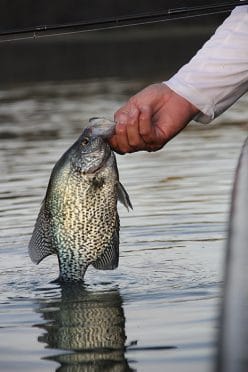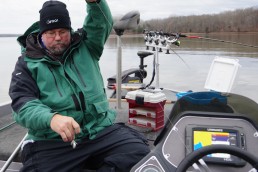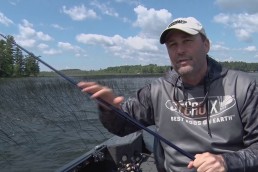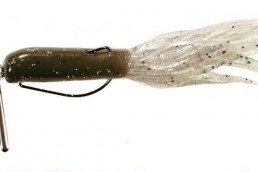Streamline Your Spider-Rigs
SHARE THIS POST
Spider-rigging is an excellent way to catch crappies in a variety of situations. The technique involves multiple rods with multiple baits. The rods, up to eight or more, are fanned out—usually at the bow of the boat—and resemble a spider’s legs. Hence the name. This spread of many rods and usually two baits per rod allows the crappie angler to present multiple baits at multiple depths. This ability to experiment with colors and depths can help narrow down the perfect bait and depth for that day. With these two factors figured out, spider-rigging for crappies becomes a very effective way to put crappies in the boat.
There is one enemy of spider-rigging for crappies and it will be discussed in this article. This enemy of the spider-rig is current and moving through the water looking for crappies. Current can pull your baits out of the strike zone as the crappie rigging sweeps up from the drag applied by this current. Same goes for those days when the schools of crappies are scattered and you need to move along in search of them. Your lines can get tangled as you move the boat, either searching for active schools or moving from brushpile to brushpile as they replenish throughout the day.
These two situations can call for heavy sinkers, just to keep the lines in order. I personally don’t like going heavier than a 3/4-ounce sinker. I’ve heard about 1- and 2-ounce sinkers being used, especially in heavy wind. The heavy weight helps keep the lines straight and in order. It also allows the rod to flex with the waves. The weight transfers the up and down movement of the boat into the rod and helps keep the baits from moving as much. The weight makes it more difficult to detect bites and diminishes the fight of the crappies as it struggles against a big lead sinker. There’s an alternative to using these super-heavy weights which keep your crappie rig straight and in order.

Line
The alternative to using these heavy weights when spider-rigging for crappies is to streamline your crappie rigging to reduce drag. It’s simple and effective and will help you catch more crappies when spider-rigging. This streamlining of your rig starts with your line. Many spider-riggers say that crappies are not line shy and use 10 or 12-pound-test line or bigger for their spider-rigs. Heavier line does tangle less than light line due to its diameter and stiffness. The diameter of the line creates a lot of drag in a strong current or as you move through the water.
When I first started spider-rigging for crappies, the story was that crappies are not line shy. It went against everything I had learned from my grandfather and my dad to always use the lightest line possible to catch more crappies. I have always used light line, 2- to 6-pound test to catch crappies. Through years of fly-fishing and then learning from a few old-timer slab crappie hunters, I’ve come to the conclusion that the crappies aren’t necessarily shy of the line. They are deterred by the action imparted on the bait, or lack of action.
Braid
Are you enjoying this post?
You can be among the first to get the latest info on where to go, what to use and how to use it!
Remember the diameter of your line is the killer of action and creates drag. I use braided line almost exclusively on my spider-rig setup. I use Spiderwire Invisibraid. It’s nearly half the diameter of mono at double the pound test. This smaller diameter is vital to streamlining your crappie rigs. There is tremendous drag on your line and it gets worse as you go deeper. The invisibraid disappears under water, but I still go with a 4- to 6-pound leader for a couple reasons.
The first reason is that I just like to use clear, light line at my bait. I know people using 20-pound braid all the way to the hook and they catch more crappies than I do. I think it’s just an old fly-fishing habit I can’t break, always use the lightest tippet possible for more bites. There is another reason and one many anglers that ask about losing tungsten to breakoffs should know. When you use 15-pound braid to the swivel and then 6-pound monofilament or fluorocarbon to the hook, the line breaks before the braid. This saves your tungsten and swivel. With steady pressure, even on light line, a gold Aberdeen hook will bend and let go, saving your hook as well. This leads us into the next step to streamlining your spider-rigs to catch more crappies.
Tungsten weights
The next step to streamlining your spider-rigs is tungsten weights. I know, I know they cost too much. Well I have found a great company that sells tungsten barrel weights at a very affordable price. The company is Woo! Tungsten. The next thing I hear about tungsten weights is that they can’t afford to lose them. When rigged properly, you shouldn’t lose any weights. The trick is to use the gold Aberdeen hooks and a heavier main line. This is where braid comes in. Tungsten is much denser than lead, therefore it is smaller. This decrease in size reduces drag on your crappie rigs, but this isn’t the only advantage.
Tungsten is so much more dense than lead that it tends to move through cover better without hanging up. Lead will actually stick to a tree limb or manmade cover, causing a hang up. Tungsten will slide over cover and structure much easier, especially when fishing rocks. Tungsten also transmits through your line and into you rod tip. This not only lets you know when you’re in some brush. When a crappie bites, you will see it in your rod tip. This helps you set the hook quicker and will catch you more crappies, especially when the crappies are biting light.
Hooks
Many crappie anglers, including me for many years, shied away from small hooks when fishing for big crappies. In recent years, however, I’ve been using some crappie jigs with a tiny hook and a lot of big crappies have been caught. I am not afraid of small hooks for big crappies anymore. With the fear gone, I’ve been able to downsize my hook and streamline my crappie rigs even more. I like to use a jig at the end of my spider-rigs because it adds a little weight and also stays ahead of the rest of the rig as it falls when dropped, keeping it from tangling as easy if you let it down slowly. I use a jig even if I am using minnows.
Swivel
Last, but certainly not least, is the swivel. Large swivels are the norm on spider-rigs. They work, if you don’t mind the bulkiness and the drag that they create. I would not even use a swivel, but it’s a must when dragging baits through the water. They tend to spin and you would have a tangled mess in short order without a swivel. The smallest ball-bearing swivel is what I like to use. Remember that these are crappies. Your swivel can be the smallest they make. A small barrel swivel will work, but a good ball-bearing swivel is the way to go. They do cost a little more, but they will foul up much less than a barrel swivel. A #2 ball-bearing swivel is very small and it’s easy to see that it will create much less drag in the water.
MWO
SHARE THIS POST
Did you enjoy this post?
You can be among the first to get the latest info on where to go, what to use and how to use it!



